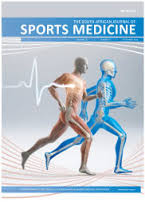Female cricket pace bowling: kinematic and anthropometric relationships with ball release speed
DOI:
https://doi.org/10.17159/2078-516X/2023/v35i1a15080Abstract
Background: Despite an increase in the professionalism and participation of female cricket, the coaching of female pace bowling is still reliant on male-derived knowledge.
Objectives: To investigate the association between key male-derived kinematic and anthropometric parameters and ball release speed (BRS) in female pace bowlers.
Methods: Eleven female pace bowlers participated in this study. BRS, and four anthropometric and five kinematic parameters were determined. Stepwise linear regression and Pearson Product Moment correlations were used to identify anthropometric and kinematic parameters linked to BRS.
Results: The best predictor of BRS explaining 89% of the observed variance was the bowling shoulder angle at ball release. The best anthropometric predictor of BRS was height explaining 53% of the observed variance. Other parameters correlated with BRS included: run-up speed (r = 0.75, p = 0.013) and arm length (r = 0.61, p = 0.046). When height was controlled for, the front knee angle at front foot contact was also correlated to BRS (r = 0.68, p = 0.044). No relationship was found between trunk flexion and BRS.
Conclusion: Faster BRS were characterised by faster run-up speeds, straighter front knees, and delayed arm circumduction similar to male pace bowlers. The lack of relationship between trunk flexion and BRS may highlight female pace bowlers adopting a bowling technique where BRS is contributed to by trunk rotation as well as trunk flexion. This knowledge is likely to be useful in the talent identification and coaching of female pace bowlers.
Downloads
Downloads
Published
Issue
Section
License
Copyright (c) 2023 South African Journal of Sports Medicine

This work is licensed under a Creative Commons Attribution 4.0 International License.
The South African Journal of Sports Medicine reserves copyright of the material published. The work is licensed under a Creative Commons Attribution 4.0 (CC BY 4.0) International License. Material submitted for publication in the South African Journal of Sports Medicine is accepted provided it has not been published elsewhere. The South African Journal of Sports Medicine does not hold itself responsible for statements made by the authors.
How to Cite
- Abstract 923
- PDF 580





.png)